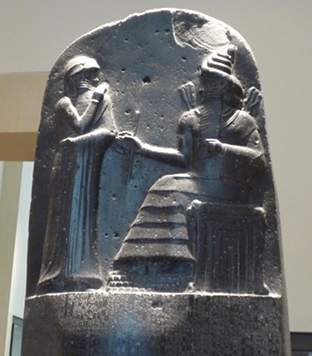The Akkadian language: grammar and vocabulary
Although cuneiform script is one of the more complex writing systems in the world, the Akkadian language is grammatically very regular. We usually study its grammar in alphabetic normalisation, without worrying about how individual words were spelled in cuneiform. These pages give you enough basic information about the Old Babylonian dialect of Akkadian to enable you to do the Cuneiform exercises and to read selected laws from king Hammurabi's stela. We have also collected together all the Akkadian vocabulary used on this website, in three convenient lists.
On all of these pages we use * to denote forms of words that are reconstructed theoretically but never actually attested.

Many kings were proud of their ability to read, write, measure, and calculate in cuneiform script, so that they could ensure justice in the land. At the top of his monument of collected laws, Hammurabi receives the symbols of kingship - probably a measuring rod and a curled up measuring tape - from the sun-god Šamaš, who was also the god of justice. Rays of sunlight shine from the seated god's shoulders and Hammurabi puts his hand in front of his face, perhaps to protect himself from the sun's penetrating rays. Photo by Karen Radner. View large image.
Nouns and adjectives. Words for naming and describing things, ideas, animals, and people, etc. Root consonants. Masculine and feminine genders. Singular and plural. Nominative, accusative, and genitive cases.
Possession and existence. Ways of describing ownership and being. Constructs. Possessive suffixes. ša. Statives. The suffix -ma. Independent pronouns (I, you, he, she, etc.).
Verbs and adverbs. Ways of describing actions and states of being. Paradigms. The preterite, durative, and perfect tenses. Vowel classes. Pronoun suffixes. Adverbs.
Sentence structure. Word order. Function words. Sentences with šumma"if". Sequential actions with -ma. Subordinate clauses with relative pronoun ša. Infinitives as nouns.
The Gt-, Gtn- and N-stems. Ways of modifying the basic (G-stem) meanings of verbs. Reciprocal actions. Motion to and away. Repeated actions. Passive verbs.
The D-stem and Š-stem. Making other people do things. Having other people do things. Tense vowels.
I weak and III weak verbs. How verbs behave when their first or third root consonant is a weak ʾ (aleph).
I w, II weak, and irregular verbs. How verbs behave when their first consonant is w. How they behave when their second consonant is a weak ʾ (aleph). Some irregular verbs.
Sound rules. A summary page, collecting together the most important rules about the way particular combinations of vowels and consonants change when next to each other.
Vocabulary. All the Akkadian words used in the Cuneiform exercises and Texts to read, in three alphabetical lists.
This is just a very simple introduction. More systematic and exhaustive treatments of the Akkadian language, and some good dictionaries, are recommended on the Further reading page.
Content last modified on 10 Jan 2017.
Eleanor Robson
Eleanor Robson, 'The Akkadian language: grammar and vocabulary', Knowledge and Power, Higher Education Academy, 2017 [http://oracc.museum.upenn.edu/saao/knpp/cuneiformrevealed/akkadianlanguage/]